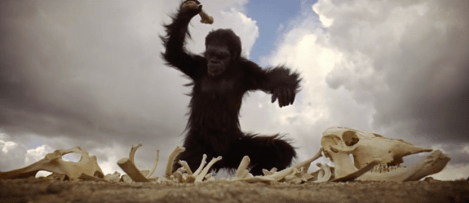In possibly the most ambitious film ever made, Stanley Kubrick seeks to show no less than the entire history of humanity, from the first humans to our potential exploration of the farthest reaches of our cosmos.

Along the way there are several appearances of a strange, black monolith, usually before some great leap forward in human knowledge. It’s a metaphor for that which we don’t yet know, the spark of inspiration that takes us to the next level of understanding of our cosmos. But it’s also a big maguffin: the reason behind a secret mission to a lunar space station and the first manned mission to Jupiter, even though its mysteries are never actually explained. 
Like the Wizard in the Wizard of Oz, it’s not necessarily the monolith that provides knowledge and advancement, but the events around it. The moon scientists, in their bourgeois comfort, aren’t ready to take the next step. It’s the brave Jupiter explorers who go to the next level, having gained new insight into humanity and the universe during their lengthy voyage.
The characters, usually the foreground in a film, are here the background, while the world they inhabit and the questions it asks about our existence take centre stage; the film assuming a god-like cosmic perspective. In the lunar sequence we see the comfort of future space travel, and the casualness with which the characters continue their mundane chitchat as technological wonders take place all around them, humanised through the simplicity of a phone call home.
On the Jupiter mission we discover that not only are we watching a space film, it also has one of the greatest artificial intelligence stories ever, examining the nature of consciousness and providing a chilling account of how a wayward computer could hold us at its mercy, even without killer robots at its command. At a time when a computer was the size of a room, plodding its way through data spools, it demonstrates incredible foresight.
Here we see shades of the black humour of Dr Strangelove. Just as the doctor himself describes the faultless logic of doomsday weapons designed to keep us safe, in 2001 there are repeated assurances that HAL cannot go wrong because in all computing history – billions of calculations – no computer has ever gone wrong. Following some unknown glitch, HAL’s sense of purpose overcomes its human hosts’ desires, but as it’s programmed to be an appealing companion, its rebellion is couched in the cool language of synthetic courtesy.
Kubrick was the ultimate perfectionist, and watching 2001 you know that every single thing you see or sound you hear from beginning to end is as it is because that’s how Kubrick wanted it to be. He sets cinematographic bar high in the opening shots of the primeval landscape, then somehow maintains this standard when in outer space.
The exterior spaceship shots are a world apart, with mechanical moving parts which look utterly real even now, and the fact everything was done practically means it will continue to look great far beyond many films made half a century later. But that’s just the beginning. Where most space films are happy with a couple of fancy exterior shots, before cutting to the inside of a spaceship where people are comfortably sitting around, Kubrick is just getting started, with rotating sets designed to show life on a centrifuge and extended weightless sequences in the vacuum of space. 
The visual wizardy is integrated into every aspect of the film with seamless perfection, including being one of the few films to truly explore the possibilities of a weightless environment. Most of the effects continue in the ‘how did they do that’ category to this day (even after seeing how they did some of it) with a level of visual innovation which has never been matched. It’s ironic, then, that the scenes which should have been easiest to film (the apes) have aged the least well.
If the film has a flaw it’s the sound design in the second act. It abandons the grace and grandeur of Strausses Richard and Johann for total silence or, even worse, laboured breathing. Presumably Kubrick wanted to show the silence of space and vulnerability of humans in it, but this unpleasant sound design stands out as a blot of ugliness in an otherwise beautiful film.
But this is is not to detract from Kubrick’s singular and greatest accomplishment: a towering monolith of hard science fiction, representing not just as an impeccable vision of the future, but a great leap forward in film making.

Pingback: Apollo 11 | Screen Goblin·
Pingback: Ad Astra | Screen Goblin·
Pingback: Shaun the Sheep: Farmageddon | Screen Goblin·
Pingback: The Terminator | Screen Goblin·
Pingback: Society | Screen Goblin·
Pingback: 2010: The Year We Make Contact | Screen Goblin·
Pingback: A Clockwork Orange | Screen Goblin·
Pingback: On iPlayer: Operation Avalanche | Screen Goblin·
Pingback: Terror Train | Screen Goblin·